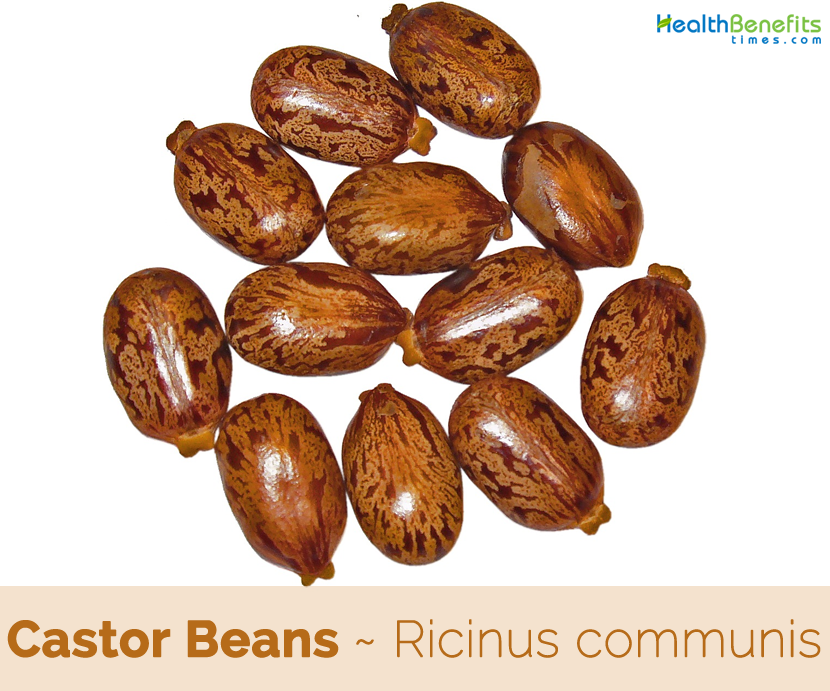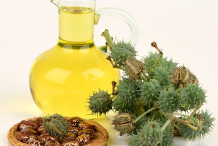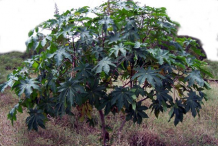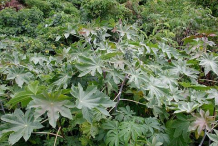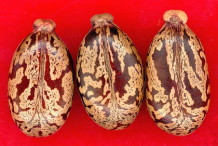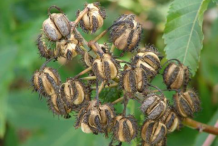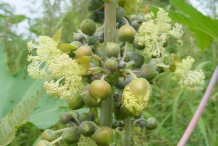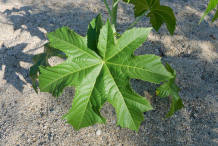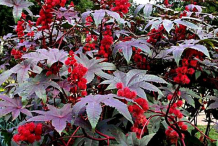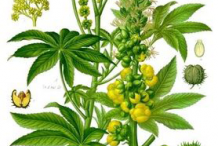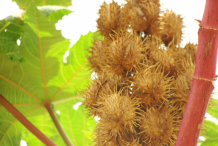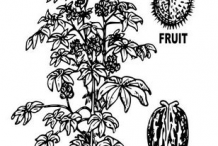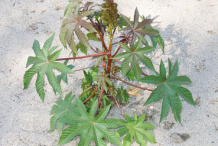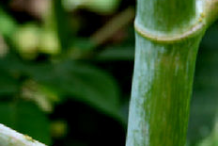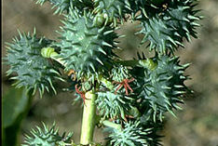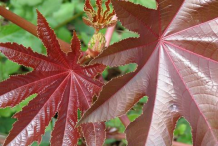| Castor beans Quick Facts | ||
|---|---|---|
| Name: | Castor beans | |
| Scientific Name: | Ricinus communis | |
| Origin | Southeastern Mediterranean Basin, Eastern Africa, and India | |
| Colors | Green turning to red or purplish red and drying to brown | |
| Shapes | Ellipsoid to globose capsule, softly spiny, sometimes smooth, roughly 3-lobed, 1.5–2.5 cm long | |
| Taste | Sweet, acrid, astringent | |
| Health benefits | Beneficial for Rheumatism, Skin Disorders, Bowel cleansing, Problem of Breast Milk Secretion, Dandruff, Natural Birth-Control, Jaundice and liver related problems, Constipation, Insect Repellent | |
| Diseases | Plant parts used | Treatment |
| Abdominal disorders | Root | In Tanzania, hot water extract of dried root is used orally to treat diarrhea, stomach ulcers and stomachaches. |
| Aerial parts | In Saudi, hot water extract of aerial parts is taken orally as a purgative and diuretic. | |
| Aching feet | Castor oil | Castor oil is used for aching feet. Simply smearing of some hand-warmed castor oil over feet is sufficient for immediate relief. For severe foot pain, enough amount of castor oil is applied over feet’s problem areas which are wrapped in some plastic (such as cling film) and after that socks are put on before going to bed. Repeated application of this for a few weeks will eventually resolve most foot pain completely. Use of castor oil in very painful heel spurs (calcium deposits) is also useful. |
| Arthritis, backache, muscle aches | Castor Oil | Castor oil applied topically can give immense from arthritis, back pain and general muscle aches and soreness. A cloth soaked in castor oil is applied over the painful joint is covered with plastic (such as cling film). A hot water bottle placed over this (this method is also known as a’ castor oil pack’). The heat will help the castor oil to penetrate the inflamed tissues and joints. Even without external heat, a castor oil pack will still work wonders. This can be done easily by putting the castor oil pack on before going to bed, leaving it to work overnight. |
| Bilharziasis | Leaves | In Senegal, a decoction of the dried leaves is externally applied for bilharziasis. |
| Chronic back ache and sciatica | Seed | The kheer of erand seeds, after boiling them in milk, is a famous household remedy for the Sciatica-Lumbago Syndrome. |
| Chronic Headache | Leaves | In Somalia, a handful of leaves are crushed and mixed with a cup olive oil. The mixture is applied to the head and 1 drop is placed in each nostril to treat chronic headache. The treatment is continued until the patient is free of pain. |
| Conjunctivitis | Castor oil | Put 1-2 drops of Castor Oil twice daily for 3 days. It may sting a little in the beginning, but later on it soothes the eyes, and eradicates conjunctivitis. |
| Constipation | Castor oil | Varying in dose from patient to patient, castor oil is a simple and harmless purgative. Usually, 20 to 60 ml of it can be taken at bedtime with lukewarm milk. Castor oil works faster if it is taken during daytime. |
| Castor Oil | Half ounce of castor oil taken internally will have a quick and mild laxative effect, giving relief for constipation. To improve the taste, take the oil by floating in a glass of warm milk or mixing it with a fresh egg yolk. | |
| Expulsion of placenta | Root | In Kenya and the decoction of the fresh root is taken orally to facilitate the expulsion of placenta or hasten parturition. |
| Seed | In Philippine, the seed is rubbed on the soles of the feet to hasten parturition or expulsion of placenta. | |
| Flatulence | Leaves | Leaves coated with oil and warmed, are commonly applied over the abdomen to give relief in the flatulence in the children. |
| Gallbladder pain | Oil | Pain from gallstones can be relieved by using hot castor oil packs. Place a castor oil pack over the area to relieve pain from gallbladder attacks |
| Hair growth | Seed | In Japan, the water extract of seeds is externally applied to promote hair growth. |
| Lumbago | Root | Roots are administered in the form of a decoction for lumbago and allied complaints. |
| Muscular distortion | Leaves | To treat muscular distortion, leaves are boiled in water, and the decoction is applied to distorted muscles. |
| Paralyzed limb | Leaves | In Somalia, A handful of leaves are crushed and mixed with a cup olive oil. The oily extract is rubbed on the skin of paralyzed limb twice a day to restore activity. |
| Period pain menstrual cramps | Castor oil | Massage some hand-warmed castor oil over the lower abdomen to relieve period pain and menstrual cramping. Using the castor oil pack method over the lower abdomen can also help reduce menstrual irregularities and uterine and ovarian cysts. It’s not unusual to feel some fluttering over the ovaries (either side or both) when a castor oil pack is applied. |
| Poisoning | Leaves | Fresh juice of leaves is reported to be used as an emetic in the poisoning by narcotics like opium. |
| Repellent | Leaves | The powdered leaves are used for repelling aphids, mosquitoes, white flies and rust mites. |
| Rheumatism | Castor Oil | The use of castor oil forms the basic treatment of rheumatoid arthritis in Ayurveda. In its early stage taking 10 to 20 ml of castor oil and 10 grams of the powder of dry ginger with a cup of warm milk daily for fortnight at bedtime reduces inflammation besides the early morning stiffness of the joints which is a characteristic feature of the diseases. |
| Rigid Knees | Leaves | In Somalia, A handful of leaves are crushed and added to a cup of sesame oil. The mixture is filtered and applied to knees. |
| Secretion of Milk | Leaves | The leaves have been also recommended in the form of a decoction or poultice, as an application to the breasts of women to increase the secretion of milk. |
| Sexual Diseases | Leaves | In South Africa, hot water extract of leaves is taken orally as an emenagogue. The powdered, dried root is applied locally as a vaginal antiseptic. |
| Seed | In South Korea, hot water extract of seeds is taken orally as an emenagogue | |
| Leaves | In Mauritius, hot water extract of dried leaves is taken orally as an emenagogue. | |
| Skin diseases | Castor oil, leaves | Castor oil and its leaves are used in many poultices which are applied over inflamed conditions of joints, boils and the enlargement of lymph nodes. Its application is also beneficial if it is done on the cracked skin of the feet. |
| Castor Oil | To treat small skin infections, apply a few drops of castor oil onto a plaster or band aid and apply it over the area you wish to treat each day. For a larger skin infection, use a piece of clean cloth soaked in castor oil instead. | |
| Sleeplessness, Insomnia | Castor oil | For the treatment of insomnia, a little castor oil is rubbed over the eyelids before going to bed. Castor oil applied in this way will bring about a feeling of deep relaxation for a peaceful slumber without the use of drugs. |
| Stomach ache, Colic | Castor Oil | To relieve stomachaches, hand-warmed castor oil is massaged gently over the abdomen and the bellybutton area (the navel). This relieves stomach pain and helps to expel trapped gas. Castor oil used in this way also helps relieve colic in newborns and helps them sleep. |
| Leaves | An infusion of leaves is used for stomach-ache. | |
| Swollen lymph nodes | Castor oil | Rub castor oil over the swollen lymph nodes each day and it will gradually shrink in size. Castor oil works by speeding up the circulation of the lymphatic system. |
| Tapeworms, intestinal worms | Castor oil | Castor oil taken internally has been documented to discharge tape worms successfully. Take a tablespoon of castor oil in a glass of warm milk in the morning and at night. The worms will be passed out of the system. |
| Root | 50 gm. of root is boiled with 2 cups of water until I cup remains.1 cup is then taken daily for 3 days. This useful for to treat intestinal worms. | |
| Tumor | Leaves | In Italy the fresh leaves are applied on the breast as a galactogogue and on affected area to treat tumor. |
| Weakened immune system | Castor Oil | Castor oil has the remarkable ability to increase our body’s lymphocytes. Lymphocytes, or white blood cells, regulate wound healing. Studies have shown that T lymphocytes may play an important role in healing. Thus castor oil applications appear to be helpful for anyone weakened immune systems. |
| Boils, Sores and swelling | Leaves | Leaves are said to be used in the form of a poultice or fomentation on sores, boils and swellings. |
Traditional uses and benefits of castor Beans
- Seed oil is considered to be fast, safe and gentle, prompting a bowel movement in 3 – 5 hours, and is recommended for both the very young and the aged.
- It is so effective that it is regularly used to clear the digestive tract in cases of poisoning.
- It should not be used in cases of chronic constipation, where it might deal with the symptoms but does not treat the cause.
- Castor oil thickens to a gel-mass which is beneficial in the treatment of non-inflammatory skin diseases and is a good protective in cases of occupational eczema and dermatitis.
- Seed is rubbed on the temple to treat headache and is also powdered and applied to abscesses and various skin infections.
- Seed is used in Tibetan medicine, where it is considered to have an acrid, bitter and sweet taste with a heating potency.
- It is used in the treatment of indigestion and as a purgative.
- Leaves are used as a poultice to relieve headaches and treat boils.
- Fresh leaves are used by nursing mothers in the Canary Islands as an external application, to increase the flow of milk.
- It is also dropped into the eye to remove the after-irritation caused by the removal of foreign bodies.
- Roasted seeds are pounded, and applied to affected area for hemorrhoids in Philippines.
- Area with facial paralysis is treated with poultice of pounded dehulled seeds.
- Seed paste is applied to wounds caused by piercing with pointed objects (nails, bamboo slats, bullet wound) and itch for 4–5 days.
- Castor seed and its oil have also been used in China for centuries, mainly prescribed in local medicine for internal use or in dressings.
- Castor seed oil is used as anthelmintic, cathartic, emollient, laxative, purgative in Unani, Ayurvedic and other ethno-medical systems.
- Traditional Ayurvedic medicine considers castor oil the king of medicinal for curing arthritic diseases.
- Leaf, root and seed oil are used for inflammation and liver disorders in Ayurveda.
- Castor oil is rubbed on the body, for chest pains and skin affections.
- Castor oil has been used as an abortifacient and is given orally, alone or with quinine sulphate, to induce labor in pregnancy at term.
- Castor oil also used as ear drops to hardened cerumen.
- Castor oil is used as a vermicide and for warts.
- Leaves are used as a poultice to relieve headaches and treat boils.
- Pounded leaves are used for difficult labor (partus) – the non-lowering of the fetus.
- Heated leaves are applied to body to relive gout pains, for sprains and swelling and pulp leaves for rashes in Indonesia.
- Pounded leaves are applied as a poultice on breast as a galactogue but castor oil is applied to breast as a galactifuge.
- Boil pounded leaves are use as wash for skin ulcers.
- Leaf sap is applied for ear-ache.
- Decoction of the leaves and roots is regarded as antitussive, discutient and expectorant.
- Pulverized bark of castor plant is used as dressing for ulcers and sores.
- Root decoction is drunk for rheumatic arthritis, paralysis, epilepsy, distension of the uterus and prolapsus ani in Philippines.
- It is so effective that it is regularly used to clear the digestive tract in cases of poisoning.
- Castor oil gel is useful in the treatment of non-inflammatory skin diseases and is a good protective in cases of occupational eczema and dermatitis.
- Castor is also applied as an emollient in the treatment of sores and as a solvent for antibiotic eye-drops.
- Castor seeds without the hull are used for birth control, constipation, leprosy, and syphilis.
Ayurvedic Health benefits of Castor bean
- Fibromyalgia: Soak a piece of flannel cloth in Castor oil. Apply to the affected area.
- Whitlow: Warm the leaves of Crinum Asiaticum. Apply Castor oil on it. Bandage it on the affected area.
- Pain: Steam the leaves of Castor. Place over the affected part and bandage. Leave it overnight. Do it daily until the problem persists.
- Galactogogue: Warm leaves of Castor Bean Plant. Use them as poultice over Breast. It helps in increasing milk secretion.
- Abdominal pain: Massage using Castor oil over Abdomen. OR: Tie warm leaves of Castor plant over Abdomen.
- Lower back Pain: Drink 10 ml root decoction of Castor Plant once a day. Use it for 15 days.
- Rheumatism: Crush Castor seeds to make powder. Take 2 g of it once a day.
- Asthma: Mix Castor Oil and Honey in 2:1 ratio. Take 1 tsp of it once a day.
- Warts: Apply Castor oil over the warts two-three times a day.
- Gout: Heat some Castor Oil. Use it for massage over inflamed Joints. This is one way. The more effective way is to use a patch. OR
- Patch
- Fold lint cloth into three layers. Size may depend upon the affected area. Dip it in Castor oil. Drip out the excess. Place over the part of the body which is inflamed; toe, knee. Cover it with a plastic sheet. Apply dry heat by using hot water bottle or an electric pad. Wrap in a towel to retain heat. Stay there for one hour. Repeat for at least three days. Acute Gout attack will disappear.
- Conjunctivitis: Use Castor oil as an Eye Drop in the affected Eye.
- Dercum: Apply Castor Oil directly to the painful or inflamed area of the body. It helps to reduce the pain and the inflammation of the body.
- Dracunculiasis: Apply leave paste of Castor over infected Wounds. It helps in extracting Worms from the Wounds.
- Burns: Use Castor Oil on the damaged Skin.
- Bunion: Massage with Castor Oil to the affected area two times a day.
- Ringworm: Take fresh or dried 10 to 15 leaves of Castor. Heat with 50 ml of Coconut oil. Apply lukewarm over affected areas at night. Do it daily for best results. OR: Mix one teaspoon of Castor oil with 2 teaspoons of Coconut oil. Apply over affected areas.
- Impotence: Apply Castor Oil on your Penis. Rub it softly.
- Breast enhancer: Take few drops of Castor oil. Massage your breast with it. Its regular use will increase your Breast size.
- Labour pain: Add 4 ml Castor oil in 50 ml warm Milk. Give it to the pregnant women twice a month. Start using this remedy from fifth month of Pregnancy. It helps in smooth delivery.
- Ulcers: Sprinkle bark powder of Castor over Ulcers.
- Abscess: Use leave paste of Castor as an ointment over Abscess.
- Panophthalmitis: Use Castor Oil as an Eye Drop. It is helpful to cure Eye Inflammation.
- Cataract: Put 2 drops of Castor Oil in affected eye twice a day.
- Constipation: Take one teaspoon Castor Oil on an empty stomach for a week. For Children: one-fourth teaspoon is advisable for children. (Note: You may mix Castor Oil with cranberry juice, Orange juice and Ginger juice for better taste. You may add it in your breakfast. Over dose may cause Diarrhea, Nausea, Stomach Cramps etc.)
- Melisma: Put 2 to 3 drops of Castor Oil on cotton pad. Rub it over affected area for 5 to 10 minutes twice a day.
- Weak Eyesight: Mix 1 teaspoon of Castor Oil with 4 teaspoon of Rose water. Put a drop in each eye daily.
- Ankle Sprain: Dip a cotton pad in Castor Oil. Place over affected ankle. Bandage. Cover bandage with plastic bag. Heat the place with hot water bottle. It gives relief.
- Arthritis: Take the leaves of Castor. Wash and pat dry. Steam them and directly apply externally to get relief from Arthritis pain.
- Arthritis: Steam or warm the leaf of Castor. Keep it over the affected joint and bandage. Do it daily at night.
- Rheumatism: Steam or warm the needed leaves of Castor. Keep it over the affected joints and bandage.
- Piles: Take equal quantity juices of Cat Tail Plant, Basil leaves and Castor oil. Boil them until it become thick. Cool and preserve it in container. Take 2 teaspoonful with hot milk at bed time. Use it for 5 days.
- Colic: Burn the roots of Sweet Flag. Mix the ash with Castor oil. Apply it over the lower Abdomen. (Note: You can also use Coconut oil instead of Castor oil)
- Flatulence: Mix the ash formed by burning roots of Sweet Flag with Castor oil. Apply it over the lower Abdomen. (Note: Coconut oil can be used instead of Castor oil).
- Stomach problems: Apply the paste formed by mixing the ash obtained by burning roots of Sweet Flag with Castor oil, over the lower abdomen. Do it regularly until the symptoms go away. (Note: You may also use Coconut oil in the absence of Castor oil.)
- Flatulence: Coat the rootstock of Sweet Flag with the layer of Castor oil. Roast it over the flame until it gets black. Take half teaspoon of ash obtained with some hot water.
- Ascaris: Roast the rootstock of Sweet Flag with the layer of Castor oil over the flame until it gets black. Take half teaspoon of ash obtained with some hot water.
- Flatulence: Take the Castor oil coated rootstock of Sweet Flag. Roast it over the flame until it chars. Mix half teaspoon of obtained ash with dried Ginger powder. Add some sugar in it. Take with a little water once in a day.
- Insomnia: Take equal quantity of Indian Sorrel leaf extract and Castor oil. Mix them well. Heat it to remove moisture. Cool. Apply it on scalp at night daily.
- Piles: Bake fresh leaves of Chinese date. Pour some Castor oil over the leaves. Apply over the affected area twice a day. Repeat for a week.
- Swelling: Crush some leaves. Fry in Castor oil. Use it as bandage.
- Constipation: Take fresh leaves of Aloe Vera. Remove spines and outer skin with knife. Cut the pulp in small pieces. Wash it with water. Dry gently with a towel. Put 1 cup obtained dry pulp over flame in a pan. Add 2 cups of Castor oil, 1 cup Date Palm candy and quarter cup sliced white Onion. Heat until moisture is evaporated. Cool it. Store it. Take 2 tsp at bedtime. Or: If Aloe Vera oil is available, take 2 tsp at bedtime.
- Stomach ache: Mix half cup sugar candy, half cup chopped Onion and quarter cup Aloe Vera pulp. Boil it with half cup Castor oil until it gets jam like consistency. Cool it down and store. Take 1 tsp 2 times a day.
- Ulcers: Boil 100 g sugar, 100 g sliced Onion, 50 g Aloe Vera pulp with 100 g Castor oil. Stir properly until it gets thick. Have 2 tsp twice a day.
- Anorexia: Take Turkey Berry, Black Pepper, Curry Leaf, Cumin and Fenugreek seed in equal quantity. Fry in Castor oil. Grind them together. Add 2 pinches of salt. Have one teaspoon with steamed rice once a day.
- Piles: Grind equal quantity of Turkey Berry, Black Pepper, Curry Leaf, Cumin and Fenugreek seed together. Fry in Castor oil. Add little salt. Take one teaspoon with cooked rice once a day.
- Gout: Extract the juice from the leaves of Land Caltrops, Damiana, Castor, and Common Milk Hedge. Add equal amount of Sesame oil to it. Boil for 15-20 minutes in a tight lid container. Massage the affected area and tie with cotton cloth.
- Elephantiasis: Grind Damiana, Castor, Horseradish, Mustard together. Apply the paste on the affected area.
- Liver diseases: Take fermented Castor Oil and externally rub it over the liver and other areas of the abdomen. Take hot Ginger tea and wring out a towel in it. Apply it over the Abdomen area. Now place a hot water bottle over the liver. It draws out toxins and helps in Liver Disorders.
- Warts: Mix Baking soda and Castor oil together to make a paste. Apply over the affected area.
- Baldness: Take equal quantity of Aloe Vera Gel, Castor Oil and Olive Oil. Put them in mixer. Blend well. Massage scalp with this twice a week.
- Liver Diseases: Externally rub Fermented Castor Oil over the Liver and other areas of the Abdomen. Now soak a towel in Ginger tea. Wring it out and apply over the Abdomen. Place a hot water bottle over the Liver. It is quite useful for Liver Disorders.
- Ascaris: Eat 100 gram Coconut in the morning. After 2 hours have 2 tablespoons of Castor oil. Most probably intestinal worms are flushed out at once, if not repeat the process.
- Baldness: Take 2 leaves of aloe vera, 1/2 tablespoon Tulsi dried leaves Powder, 1 tablespoon Fenugreek Seeds Powder and 1 tablespoon Castor Oil. Extract the gel of Aloe Vera in a bowl. Add other ingredients. Mix well. Apply it on scalp as well as on hair. Cover your head and keep it overnight. Next morning, wash your head with mild shampoo.
- Blisters: Mix Apple Cider Vinegar and Castor oil together. Apply to the affected area once or two times a day.
- Dry Lips: Mix castor oil and flax seed oil in equal amount. Apply 2-3 times a days on the lips.
- Orchitis: Take dry caesalpinia bonduc seeds. Grind them. Add castor oil to make a paste. Apply it over affected area and cover it. Do it once a day.
- Piles: Mix equal amount of powder of castor and Terminalia chebula. Take 3 g of it during bedtime.
- Jaundice: If a pregnant women is suffering from jaundice, consume 5-10 ml fresh leaf juice for five days. It is beneficial for overcoming jaundice.
- Jaundice: Consuming 6 ml root juice along with 250 ml milk is considered beneficial for jaundice.
Culinary Uses
- Seed contains edible oil, used in cooking.
- Inflorescence and very young fruits are boiled and relished as lalab with rice in Indonesia.
- Ripe seeds are also eaten after roasting.
- The Igbo in Nigeria prepare a traditional soup, ogiri egusi, from the fermented seeds.
- Mature leaves are dried and stored until winter when they are eaten as a vegetable in Korea; in Bengal, India, the young fruits are eaten.
Dosing
Doses mentioned below are based on scientific research, publications, traditional use, or expert opinion. Many herbs and supplements have not been carefully tested, and safety and effectiveness may not be proven. Brands may be made differently, with variable ingredients, even within the same brand. The below doses may not apply to all products. You should read product labels, and discuss doses with a qualified healthcare provider before starting therapy.
Adults (18 years and older)
- For most conditions, 15-60 milliliters of castor oil has been given by mouth.
- For bowel cleansing, a single dose of 30-80 milliliters of castor oil with water has been used.
- To prepare for a colonoscopy, 60 milliliters of castor oil has been taken by mouth the night before the examination, with only water to be consumed afterwards.
- For birth control, castor seeds, weighing 2.3-2.5 grams, have been given as a single oral dose with water after 4-5 days of menstruation.
- To cause childbirth, a single 60-milliliter dose of castor oil has been taken by mouth.
- To reduce inflammation of the eyelash follicles, castor oil has been applied over the eyelashes and eyelids at least 3-4 times daily for one week.
- For conjunctivitis, 1-2 drops of castor oil have been applied to the eyes twice daily for three days.
- For dry eyes, eye drops containing a castor oil and water mixture have been used three times daily for 30 days.
- For eye styes, two drops of castor oil in the affected eye 3-4 times daily for two days have been used.
Children (under 18 years old)
- Consult a physician before giving castor oil to children. Use in children for occasional constipation is generally avoided.
- For children under two years old, 1.25-7.5 milliliters of castor oil by mouth has been used.
- For children 2-11 years old, 5-15 milliliters of castor oil by mouth has been used.
- For children over 11 years old, 15-60 milliliters of castor oil by mouth has been used.
- For colic in infants, a hot castor oil rub massaged into an infant’s belly has been used.
Other facts
- Castor plant is often cultivated as an ornamental plant and used for landscape purposes in parks, gardens and other public areas.
- It is also planted as a hedge plant in India, as a shade plant in Costa Rica or for sand dune stabilization in Libya.
- Oil is well-tolerated by the skin and so is occasionally used as a vehicle for medicinal and cosmetic preparations.
- Seed oil is an ingredient of soaps, polishes, flypapers, paints and varnishes.
- It is also used as a lubricant and for lighting and as an ingredient in fuels for precision engines.
- Oil is used in coating fabrics and other protective coverings, in the manufacture of high-grade lubricants, transparent typewriter and printing inks, in textile dyeing and in the production of ‘Rilson’, a polyamide nylon-type fiber.
- Dehydrated oil is an excellent drying agent which compares favorably with tung oil and is used in paints and varnishes.
- Hydrogenated oil is utilized in the manufacture of waxes, polishes, carbon paper, candles and crayons.
- Fiber for making ropes is obtained from the stems.
- The growing plant is said to repel flies and mosquitoes.
- When grown in the garden it is said to rid it of moles and nibbling insects.
- Leaves have insecticidal properties.
- Cellulose from the stems is used for making cardboard, paper etc.
- Castor plant is planted for biodiesel production in Brazil.
- Leaves are utilized as fodder for silkworms in Korea and in India for the Eri silkworm, Philosamia ricini.
- In rural areas in many countries, the abundant seeds are used by children for slingshot balls.
- Attractive castor seeds are used in jewelry, mainly necklaces and bracelets.
- In rural areas, castor oil on its own or mixed with kerosene used for illumination.
- Castor oil is used in crumb-rubber manufacturing, where it prevents rubber crumbs from coagulating.
- In the textile industry, castor oil is used for moisturizing and removal of grease in fabrics, and for the manufacturing of waterproof fabrics.
Precautions
- Whole plant is very poisonous; even one seed has been known to be lethal to children.
- Seed coat contains an extremely lethal poison that was once used by the KGB to dispose of their enemies.
- Leaves are only mildly poisonous.
- Toxic principle is water-soluble so is not found in the oil.
- It may cause abdominal discomfort, cramping, nausea, loss of fluid and electrolytes.
- Do not uses during pregnancy as may induce premature labor and miscarriage.
- Flavor is somewhat unpleasant, however, and it can cause nausea in some people.
- Prolonged use may cause fluid and electrolyte loss.
- Must not be administered to patients of Intestinal Blockage, Acute Inflammatory Intestinal Disorder, Appendicitis, or Abdominal Pain.
- Do not use during breast feeding.
- Do not use if suffering from abdominal pain, Kidney problems or Intestinal infection.
- Keep away from Children.
- A poison Ricin is produced by castor beans. It may cause death if ingested orally, inhaled or injected.
- Fruits and seeds are extremely toxic and should not be eaten raw.
- Avoid use of unprocessed castor seeds or beans, as they may be toxic when touched or taken by mouth.
- Avoid repeated castor oil use, due to the risk of dehydration and laxative dependence when taken by mouth.
- Avoid using by mouth in patients with signs of appendicitis or any gastrointestinal disorders.
- Avoid taking other medications or herbs and supplements within two hours of taking castor oil by mouth.
- Avoid in individuals with a known allergy or sensitivity to the castor bean, castor oil, or other members of the family Euphorbiaceae.
- Do not consume for more than 8–10 days.
References:
https://www.itis.gov/servlet/SingleRpt/SingleRpt?search_topic=TSN&search_value=28393#null
https://davesgarden.com/guides/pf/go/75517/
http://www.hear.org/pier/species/ricinus_communis.htm
https://npgsweb.ars-grin.gov/gringlobal/taxonomydetail.aspx?id=31896
https://pfaf.org/user/Plant.aspx?LatinName=Ricinus+communis
https://www.cabi.org/isc/datasheet/47618
http://www.theplantlist.org/tpl/record/kew-178867
http://www.missouribotanicalgarden.org/PlantFinder/PlantFinderDetails.aspx?kempercode=b459
http://www.floracatalana.net/ricinus-communis-l-
https://www.botanical.com/botanical/mgmh/c/casoil32.html
https://plants.usda.gov/core/profile?symbol=rico3
https://www.pinnaclehealth.org/wellness-library/blog-and-staywell/health-resources/article/39520


